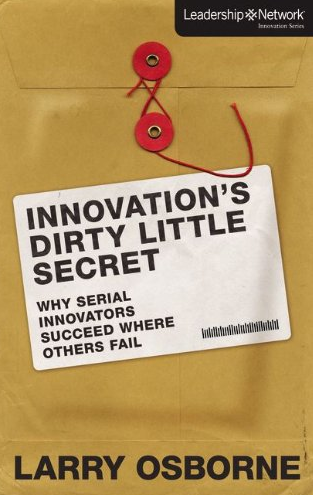
My friend, Larry Osborne, leads North Coast Community Church with a group of gifted leaders. I enjoy his writing as much as any pastor who writes on leadership. This October, he releases a book entitled, Innovations Dirty Little Secret. (I just sent an endorsement after pre-reading the book.) Whether you like the title or not, this book is worth getting for the chapter on mission and the short section on vision alone.
In short, there are very few books that tie organizational clarity to practical aspects of innovation in a ministry context.
Here are three essentials he talks about for mission, with a chapter subtitle, "How clarity accelerates innovation." Larry writes that mission must be:
- Ruthlessly Honest
- Widely Known
- Broadly Accepted
Here are some snippets
RUTHLESSLY HONEST
First, to be useful, a mission statement must be ruthlessly honest. It should reflect your organization’s passionate pursuit, not merely your wishful thinking, your marketing slogans, or a spirit of political correctness. Anything less is disingenuous. And worthless. It doesn’t take long for people inside and outside an organization to recognize what the real priorities are. If your mission statement says one thing but all of your decisions and actions pursue something else, the predictable result will be cynicism and confusion.
WIDELY KNOWN
A second trait of a powerful mission statement is that it’s widely known. Even if it’s ruthlessly honest and laser focused, if it’s too wordy and complex to remember, it’s pretty much useless. To impact the daily decisions of an organization, a mission statement must be easily remembered and repeated ad nauseam—and then repeated again. When a mission statement is so complex and wordy that no one remembers what it says without stopping to re-read it, there’s not much chance that daily decisions will be made in light of it or even align with it. Too long to remember is too long to be useful.
BROADLY ACCEPTED
In the early days of a startup, it’s easy to gain broad acceptance of your mission. If it’s genuine and clearly stated, you’ll attract people who agree with it and you will repel those who don’t. That’s why so many startup teams have a Camelot-like sense of unity.
But it’s difficult to maintain that sense of unity and broad acceptance of the mission over time. As organizations grow and mature, there’s almost always some measure of mission creep. It’s inevitable. New staff and new leaders subtly redefine the mission in terms of their own personal perspectives, preferences, or the position they have within the organization. And those subtle shifts add up. Eventually, many organizations end up with competing silos, each with a slightly different.
WHY MISSION CLARITY ACCELERATES INNOVATION
A clear and memorable mission statement will tell you what to feed and what to starve, what to focus on and what to ignore. It will give you a framework by which to judge success and failure.
Without mission clarity t’s easy to be seduced by every innovative idea or proposal that appears. Especially if something is novel, has been successful elsewhere or promises to make a solid short-term profit. But over the long haul, if something doesn’t take us toward our mission, it takes us away from our mission, even if it’s a great idea and a potential game-changing innovation elsewhere.
It’s hard to hit the bull’s-eye when it’s a moving target, or when everyone thinks it’s a different target, or no one knows for sure what the target is.
NORTH COAST'S MISSION
Making disciples in a healthy church environment
